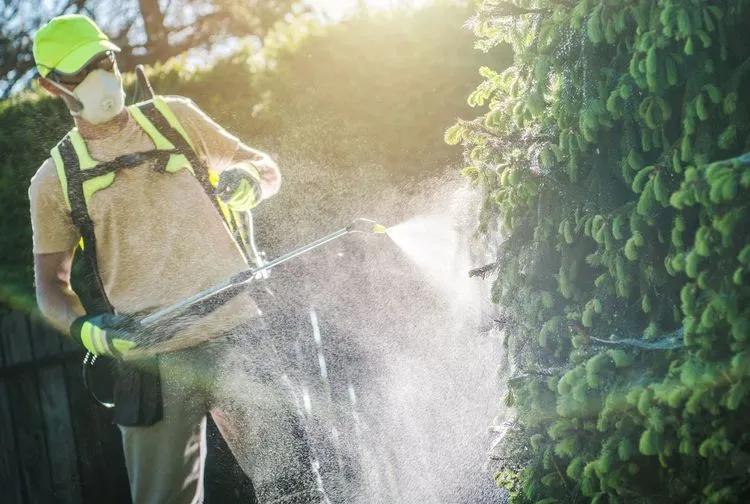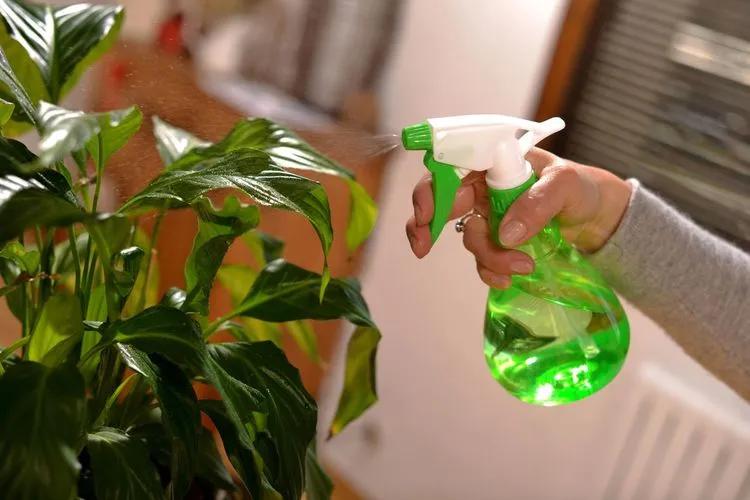Houseplant pests may become a real pain in the neck of every plant parent. To combat pests, you can find a variety of tools. But every gardener still thinks about household and generation-proven natural pesticides for indoor plants. In this article, we have compiled a list of common pests and remedies of natural origin.
Most common pests

-
Spider mites. These are the most common houseplant pests, mainly active in winter. Affected plants are weakened: the leaves first turn pale, become gray and dry, and then turn yellow and dry out in some species.
-
Aphids are tiny pests with a long body up to 2 mm, creating large colonies. They are easily distinguishable with the naked eye. The affected parts of the plants begin to curl, bend, and wither quickly and then turn yellow and die off. And the more aphids spread, the more noticeable growth disturbances and plant depletion are.
-
Thrips are one of the most dangerous pests. When damaged, the decorative effect of the plant is restored for an amazingly long time. In micro-punctures, silvery and white dots appear and grow, gradually silvery-yellow spots, uneven in relief, cover everything with uneven mosaics. Discolored leaves and flowers turn brown and die off.
-
Diaspididae. They are dangerous for all indoor plants - even cacti and orchids. When infected, white or yellow spots appear on the leaves, shoots, and leaves are gradually depleted and dry out. A sweet, sticky coating covers the plant even before visible traces. They can be defeated by natural organic pesticides.
-
Mealybug. These pests resemble cotton balls. A plant affected by a mealybug looks lethargic and drooping. Growth slows down at first and then stops altogether. Sticky honeydew with a sooty fungus, traumatizing to the roots and aerial parts at the same time, quickly destroys the plant.
-
Fungal infections. Fungi are hazardous for indoor plants. They are widespread in nature so that the plant can become infected from nearby flowers or soil (taken from an unchecked place). Common symptoms of fungal diseases include spots on stems and leaves, decay of plant parts.
How to fight pests: common types of pesticides
 Pesticides are agricultural substances of a chemical nature designed to combat pests, plant diseases, parasites, weeds, and insects. Depending on the composition of the active substance, the following types are distinguished:
Pesticides are agricultural substances of a chemical nature designed to combat pests, plant diseases, parasites, weeds, and insects. Depending on the composition of the active substance, the following types are distinguished:
-
Organic preparations or natural pesticides - preparations of natural origin. Such pesticides can consist of living organisms, bacteria, fungi, other natural sources, and minerals. Most are environmentally friendly and safe compared to chemical-based pesticides.
-
Inorganic drugs - substances of a chemical nature. Pesticides of this group are highly effective, have a longer period of protective action, and increase toxicity.
To treat houseplants, you may need:
-
Insecticides- these are drugs used to control insect pests. According to the mode of action, insecticides are divided into contact and systemic. Mainly systemic insecticides are applied using a foliar spray. Others go into the soil, absorbed by the roots, and then move to the stems and leaves. Actara is an example of such an insecticide.
-
Fungicides are substances (of chemical or biological origin) that inhibit the growth of fungi on plants. Fungi can cause many plant diseases and affect their healthy growth.
Depending on the chemical properties, they are:
- inorganic (compounds of sulfur, copper, mercury, nickel, iron, manganese, and potassium);
- organic (decomposed by living organisms and do not contain heavy metals).
What are natural pesticides?
Every gardener has ever thought about natural alternatives to pesticides. Although chemicals are considered the most effective pest control method, they are harmful to plants' health and the environment. Natural pesticides for plants are safe and cheaper compared with chemical ones.
We've prepared the list of natural plant pesticides:
undefined
Saline solution
It is used to treat plants infected with spider mites. Just dissolve 2 tablespoons. Heap spoonfuls of Himalayan salt in 4 liters of water and spray the solution on the affected areas. Milk also can be added to this solution to fight fungal infections. The salt dehydrates the fungus, and the milk allows the salt to stick to the leaves. You can treat the leaves with this natural pesticide once in 2-3 days.
Essential oils
Essential oils are effective against pests and diseases. Add 2-3 drops of essential oils (lemon, orange, lavender, tea tree, mint, cedar, pine) per 100 ml of water. Mix it and spray it onto your plants.
Soap solution
Such a solution is used as an initial stage in the fight against any pest infestation and as one of the most effective means for spraying plants with a sooty fungus infestation, crops affected by honeydew, washing leaves when infected with a diaspididae, and in the fight against spider mites.
Neem oil
One of the best natural pesticides for garden is neem extract. Its action extends to 200 varieties of sucking and chewing parasites. The advantage of neem oil is its non-toxicity and safety for plants. To prepare the solution, pour 1 tsp extract into a liter of warm water. Mix thoroughly and add half a teaspoon of insecticidal soap there. Then start working on the damaged plantings, but do not forget to shake the solution so that the neem oil does not settle to the bottom.
Chrysanthemum tea
 Such an unusual tea affects the nervous system of insects, immobilizing them. Tea has this effect thanks to the chemical substance pyrethrum. Pour 100 grams of dried flowers with a liter of boiling water and boil for 20 minutes. Then strain, let it cool, and spray. The chrysanthemum tea can be stored for up to two months.
Such an unusual tea affects the nervous system of insects, immobilizing them. Tea has this effect thanks to the chemical substance pyrethrum. Pour 100 grams of dried flowers with a liter of boiling water and boil for 20 minutes. Then strain, let it cool, and spray. The chrysanthemum tea can be stored for up to two months.
Remember that natural pesticides have milder action on the pest; therefore, the results may not be instant. The correct use of substances will ensure the elimination of insects that damage trees and other crops in your area.
